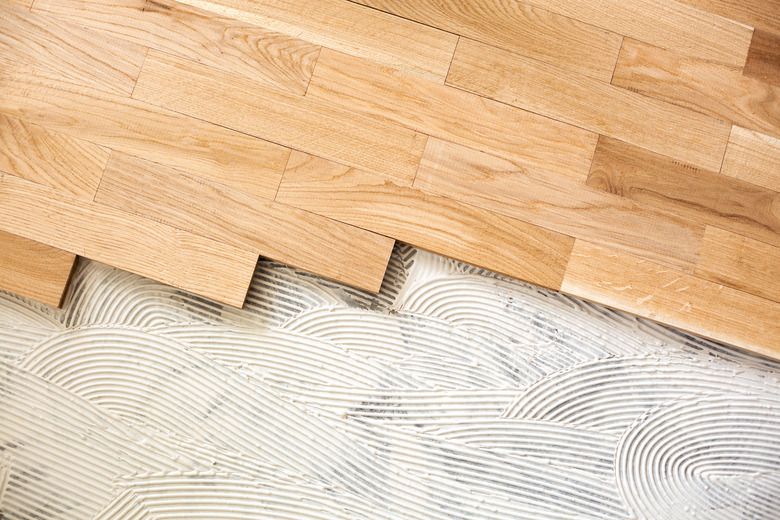The Best Wood Filler For Subfloors
Subfloor materials including plywood, oriented strand board (OSB) and, to a lesser degree, particleboard, are fairly stable, and any gaps that might develop between sheets are unlikely to widen. For that reason, any subfloor filler you use does not have to be particularly elastic. Most flooring pros would agree with Glenda Taylor's advice on the Bob Vila website to rely on floor leveling compound almost exclusively. Polyurethane subfloor caulk is an alternative when you expect some movement, but such cases are rare.
Filling Gaps in a Subfloor
Filling Gaps in a Subfloor
Leveling compound comes in two basic formulations. Cement-based formulations, such as Henry 555 LevelPro, are designed for wood and concrete subfloors, while patching compounds, such as Fix-It-All, are composed primarily of calcium carbonate and silica quartz and are intended primarily for wood. Both harden within about two hours to form a reliable seal against moisture and air circulation.
Fix-It-All is a more appropriate product to use for spot filling, because it's easier to mix to a stiff consistency, which you need for filling larger gaps even if it takes more than one application. It can also be sanded, so you can more easily flatten holes and gaps that you overfill. If you need to fill a large area, especially one with high spots and depressions, you're better off using a leveling compound, because it has a longer open time and is more workable.
Fill Plywood Subfloor Gaps
Fill Plywood Subfloor Gaps
When installing a new subfloor, it's easy to avoid gaps by simply butting the subfloor sheets as closely as possible before fastening them. You don't have any control over a subfloor that you just uncovered by removing carpeting or some other flooring, however, and it's important to fill existing gaps to guarantee thermal and moisture isolation and protect your new flooring. If you're installing sheet vinyl or peel-and-stick tiles, you also want to fill knots that you would be able to feel under the flooring.
An effective strategy for filling large gaps is to mix patching compound to a stiff, mortar-like consistency, trowel it into the plywood subfloor gaps and wait for it to stiffen before troweling it smooth. Some sanding may be needed when it sets completely. Patching compound has a fairly short open time during which it's flexible enough to spread, so mix only as much as you can apply in about 15 minutes and work quickly.
Although patching compound works well for gaps between subfloor sheets that are less then 1/4 inch in width, you can also fill these with polyurethane subfloor caulk. One advantage of this method is that polyurethane bonds the sheets together and prevents the gaps from widening. Moreover, caulk is easier to apply, so it may be the preferred method for a subfloor that has small gaps but is otherwise in good condition.
Checking the Floor Level
Checking the Floor Level
A subfloor should be level (no slope) and flat, with no depressions or high points. You can check both by dropping marbles on the floor and watching where they roll. If they collect in certain spots or always roll away from others, those are places that need attention.
Unlike a concrete subfloor, you can usually knock down high spots on a wood subfloor by sanding, and you can always fill depressions with patching compound. Small variations in height probably won't be felt under hardwood, but large ones will, and they can cause laminate sheets to separate. A floor with a large number of height variations is a good candidate for floor leveling compound, which you should spread after filling all the large gaps with patching compound.
